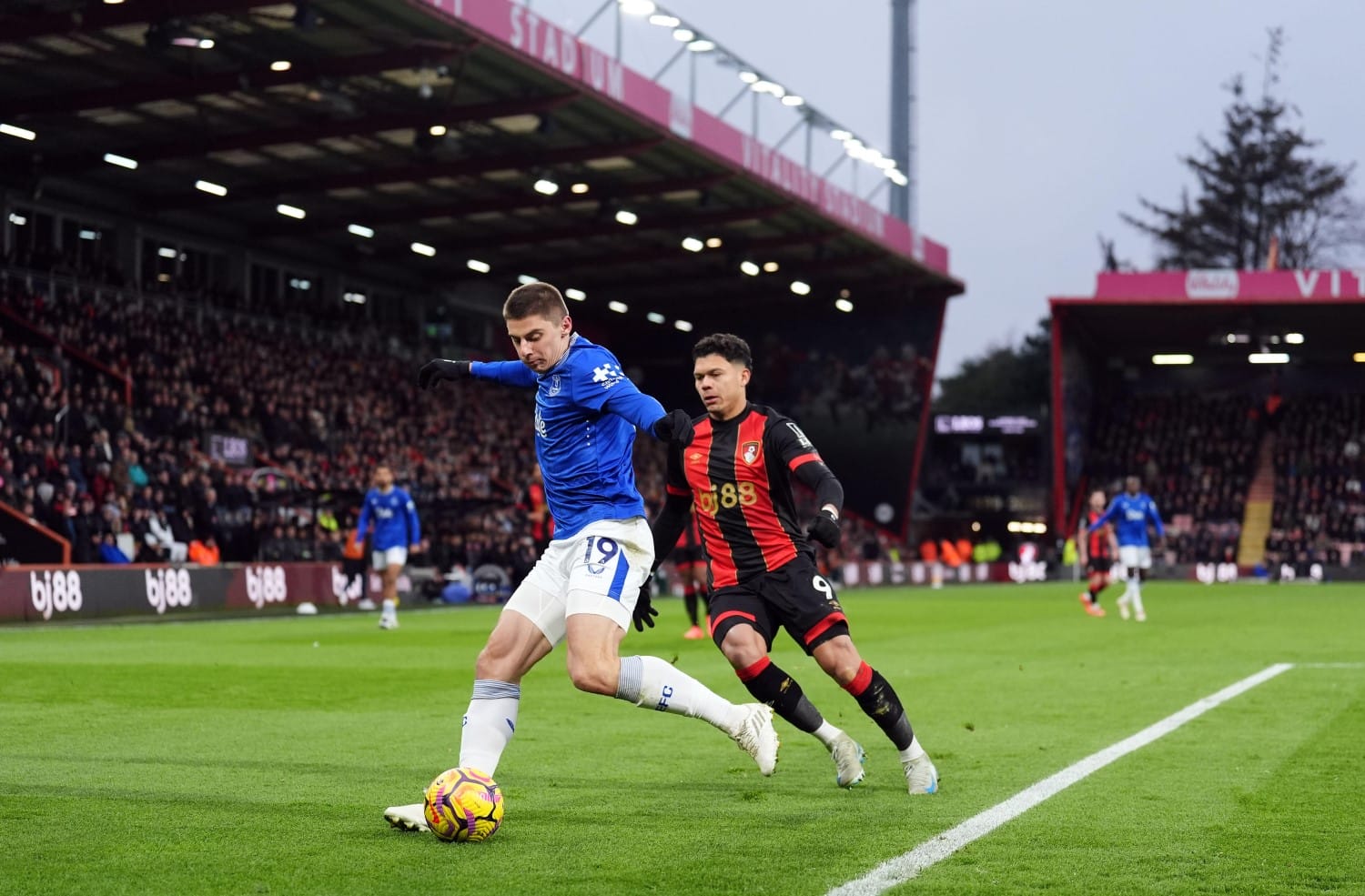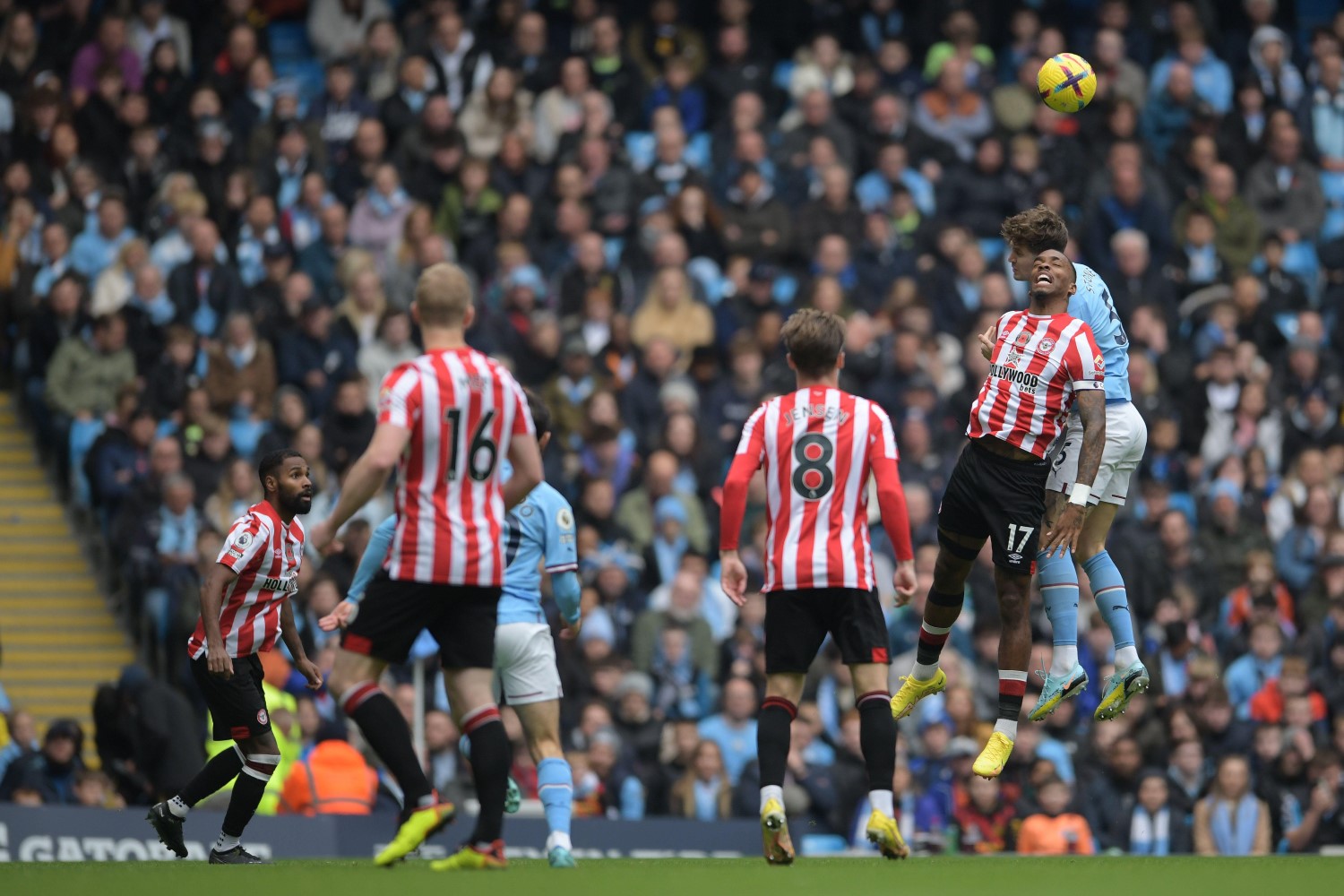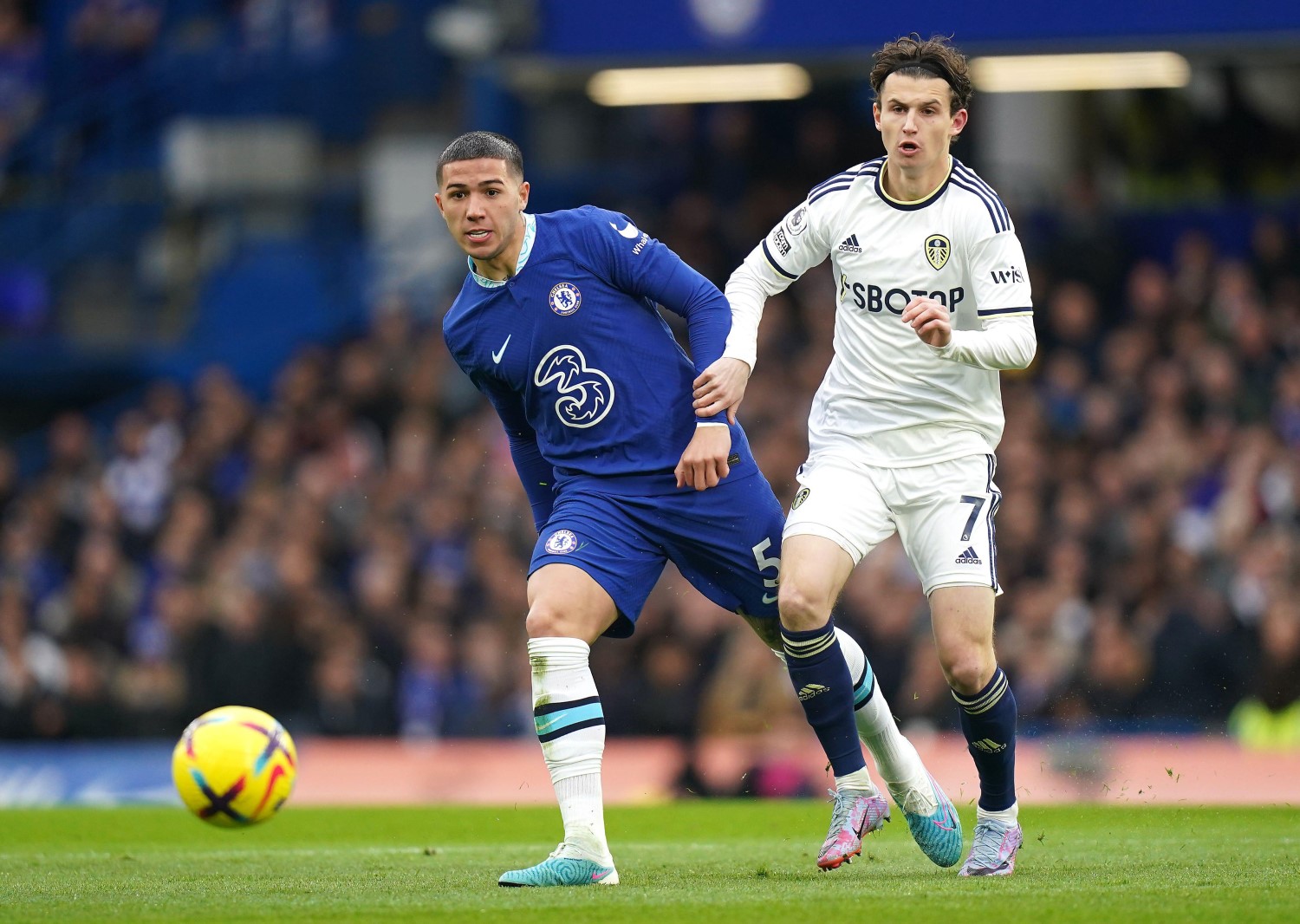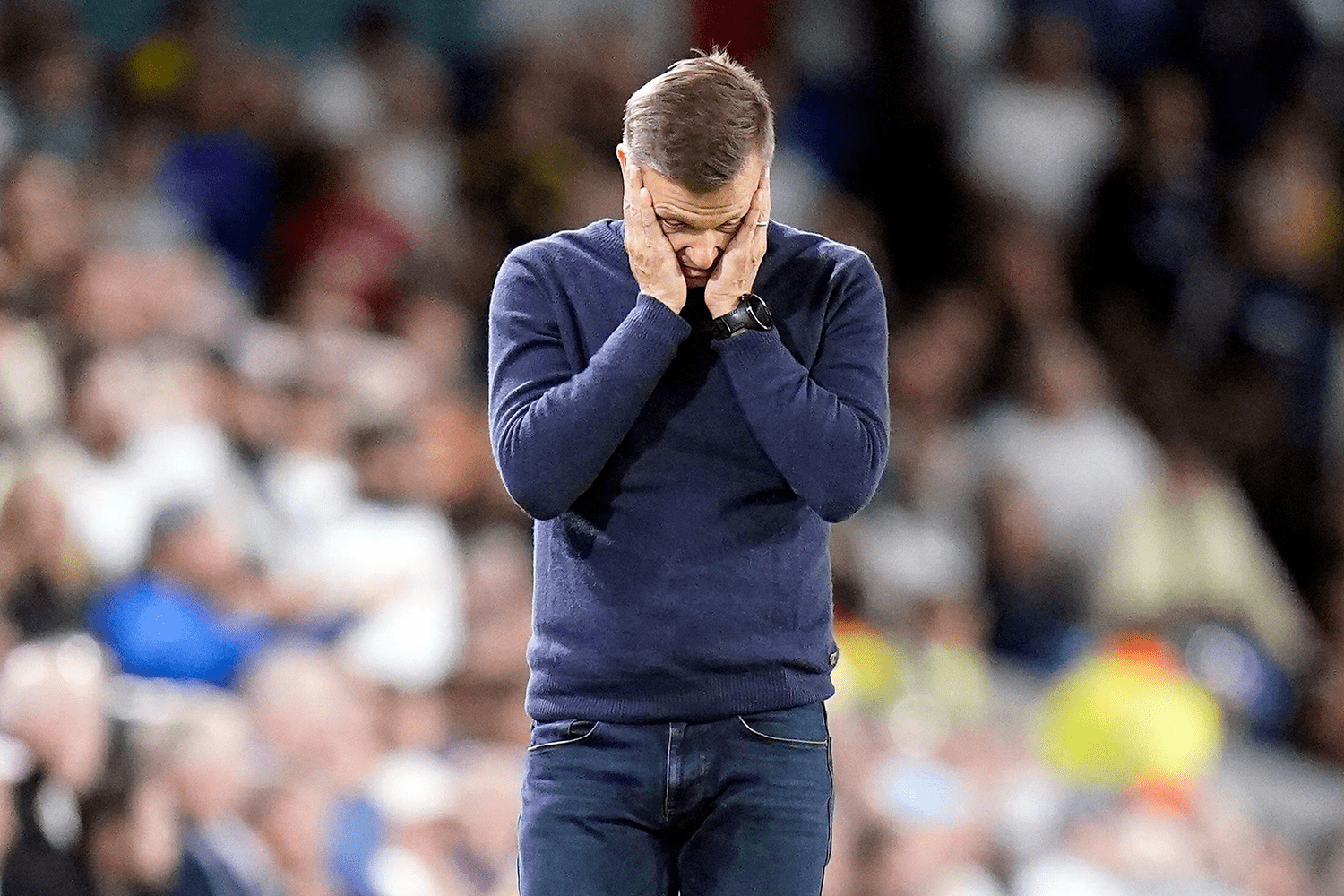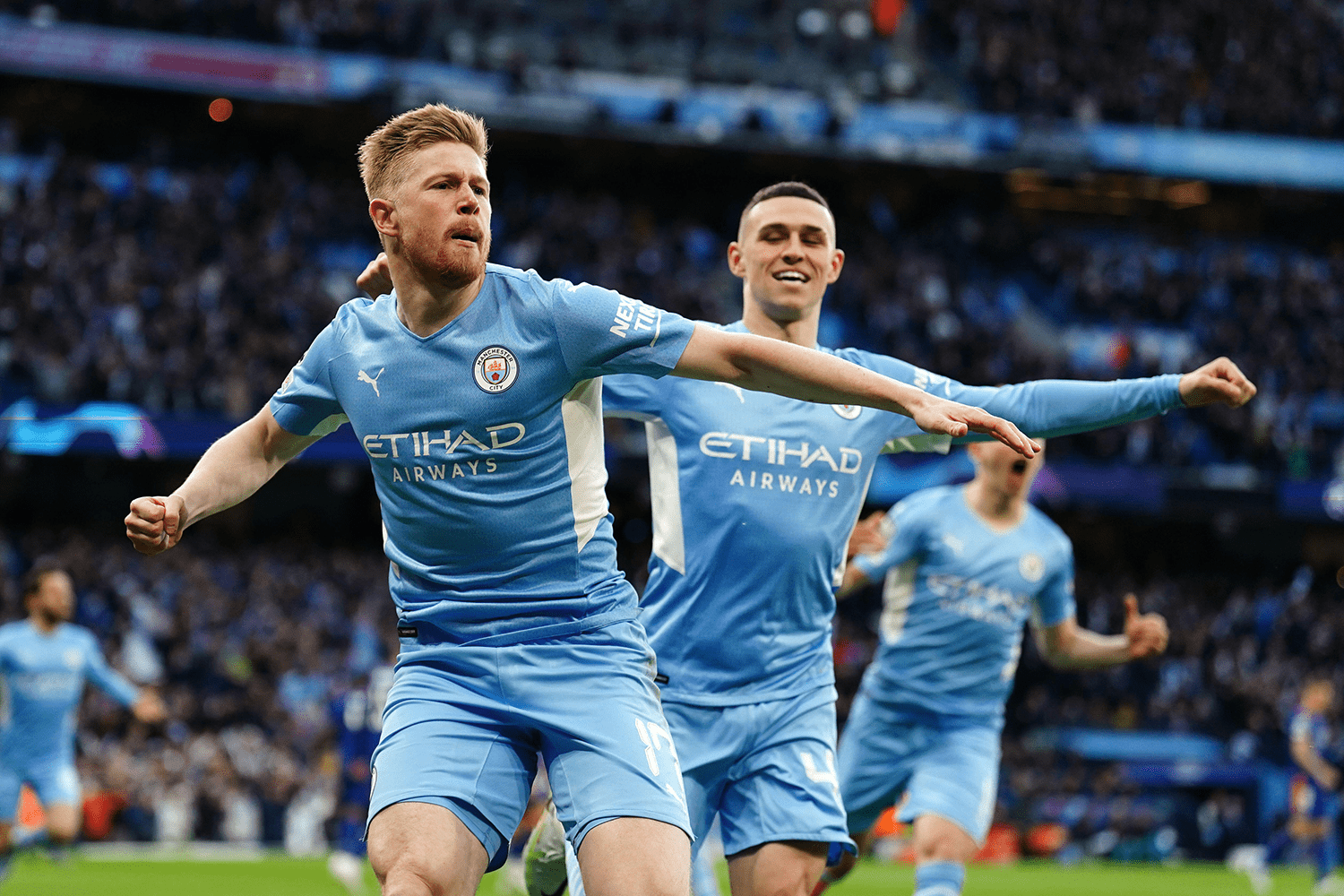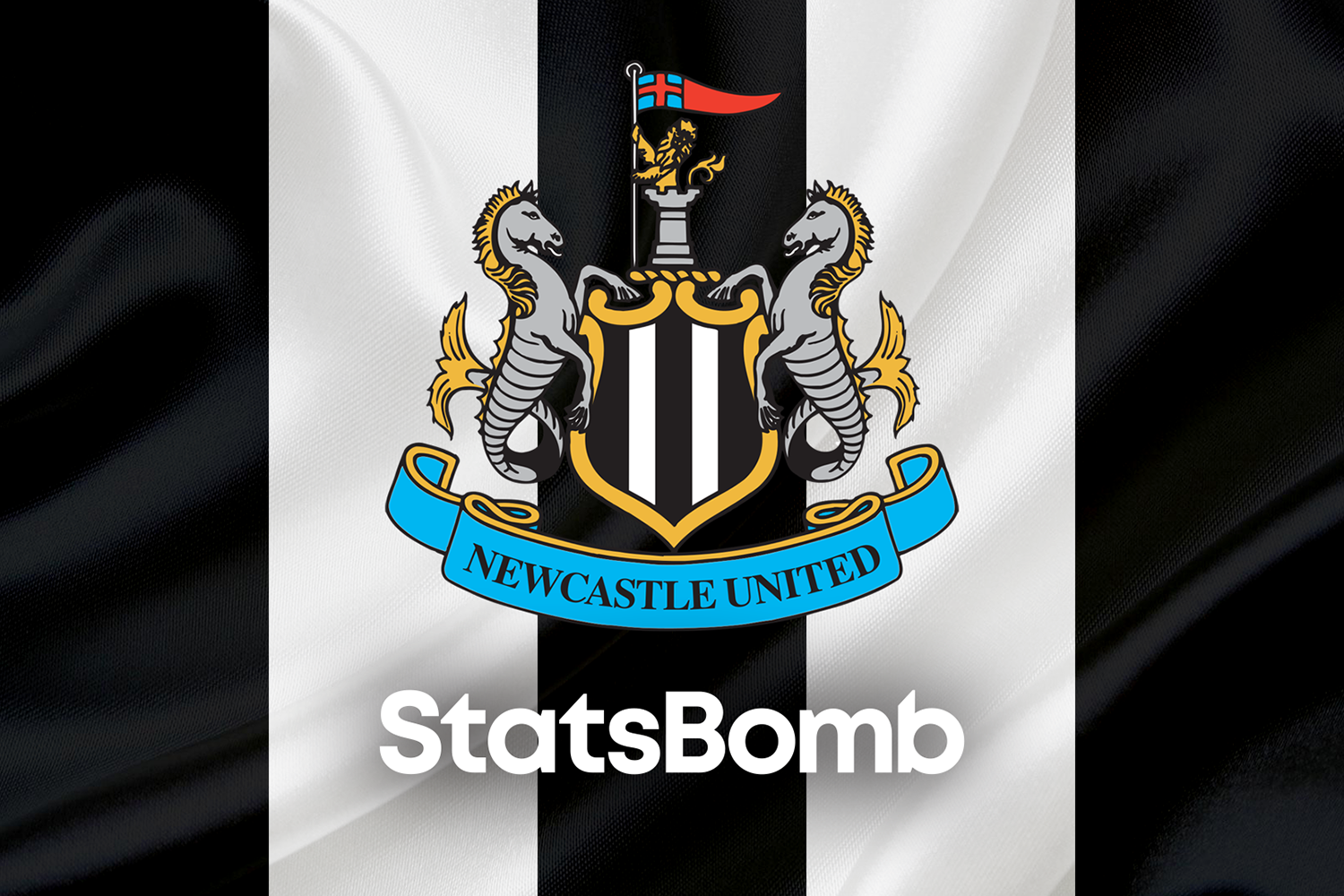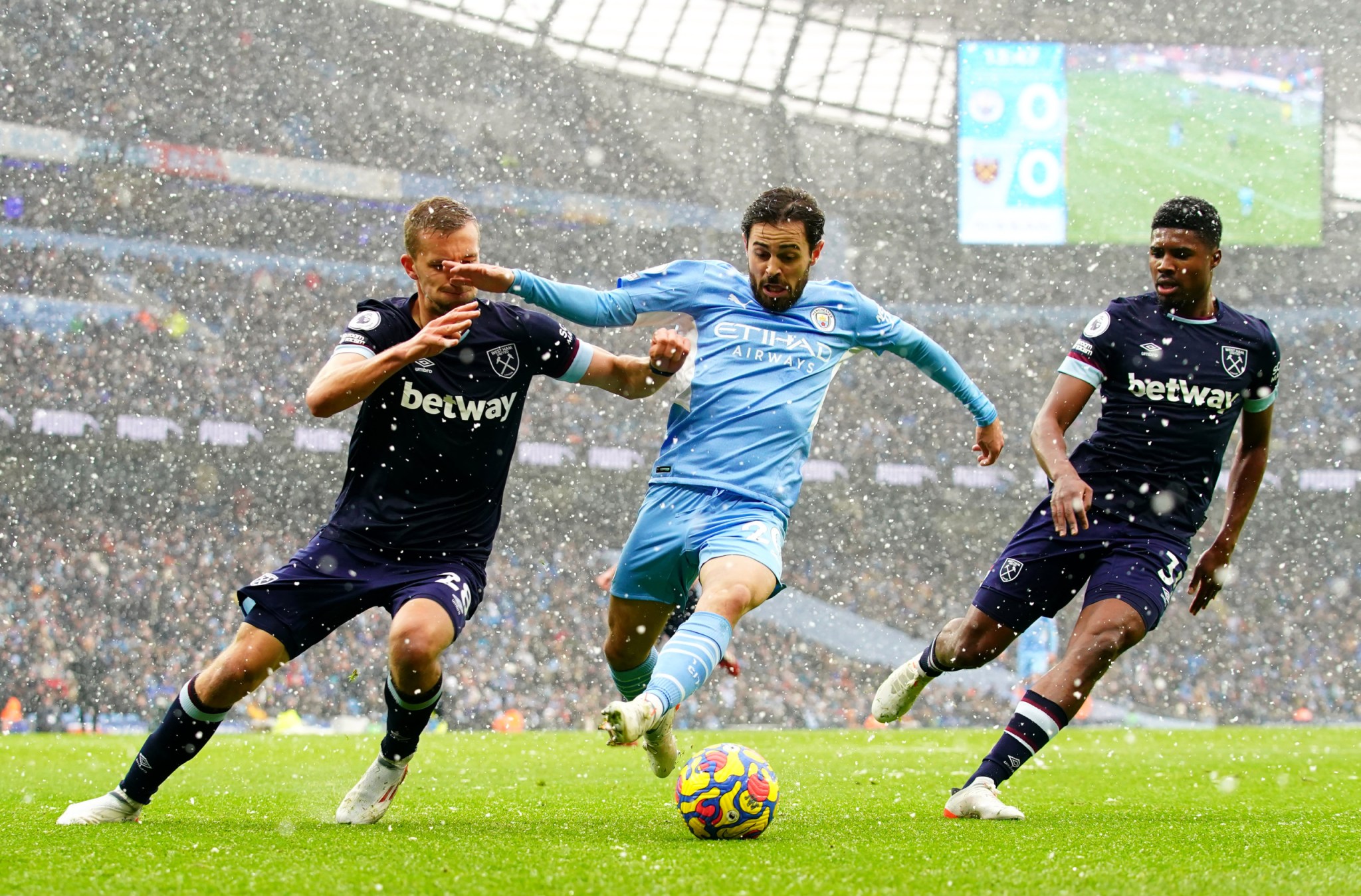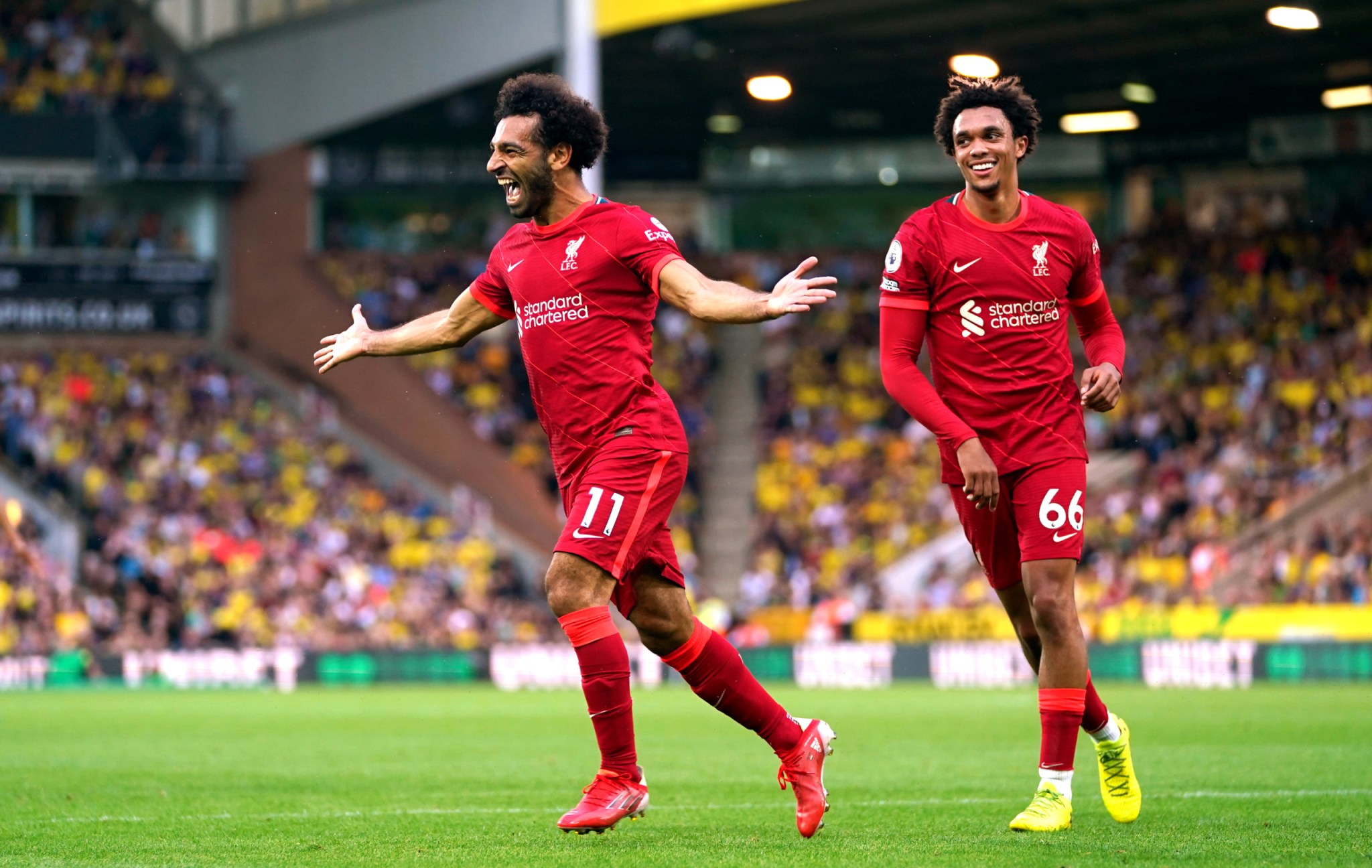Wolverhampton Wanderers FC has signed a multi-year deal with StatsBomb to use its data and analytics services. This agreement demonstrates the club's ambition to build upon its recent European and domestic successes by utilising deep data and innovative platforms in its recruitment and performance analysis departments. As part of the agreement, the English Premier League club has also become the latest elite team to sign up for StatsBomb 360, a product crafted at the forefront of innovation in football analytics. StatsBomb 360 adds a snapshot of player locations around every on-the-ball event during a match. The StatsBomb 360 data will enable Wolves to easily analyse its defensive shape, available passing lanes and decision-making, ball receipts in space, line-breaking passes and much more. Wolves will also have access to StatsBomb's market-leading core data set and StatsBomb IQ platform. The performance data includes a number of unique metrics such as pressures by player and team, pass footedness and shot impact height. The StatsBomb IQ platform will enhance the club's recruitment and opposition analysis capabilities by making it easier to find suitable players via customisable templates and unearth patterns in its opponents' play. Shergul Arshad, Chief Commercial Officer, StatsBomb, said: "We are thrilled to be working with Wolverhampton Wanderers. The Premier League is fiercely competitive. By choosing StatsBomb as its data and analytics supplier, the Wolves scouting team has the best tools to find players across a wide range of leagues, and its match analysts have unparalleled data to evaluate opponents." Speaking about the agreement, Mathew Pearson, Head of Performance and Research, Wolverhampton Wanderers FC, said: "At Wolves we constantly look to be innovative and progressive and to embrace new ideas and technologies. The addition of StatsBomb has allowed us to further integrate data into both our analysis and recruitment work flows and has been a valuable asset to both”
Sorry to keep you waiting, Villa fans. There’s been a lot to evaluate. The club made big forward strides last season, strides so big that most people forgot all about the anxious last-day wait Villa had to endure just to maintain their Premier League status at the end of 2019/20. Now established in midtable, the club faces a new challenge. Before we get into the summer’s events and where that leaves Villa in the short and medium-term, let’s take a quick look back on the 2020/21 season as a whole. Surviving by a single point the season before, the Villains added a whopping 20 points to their tally to finish comfortable in 11th place, a full ten points ahead of Newcastle in 12th. This wasn’t just keeping relegation at arm's length but shoving it out of sight and out of mind. An improvement in the on-pitch performances powered the leap up the table: Villa turned a near-league-worst expected goal difference, -0.62 xGD per game, into a comfortable midtable process, bang on +0 xGD per game over the whole season. 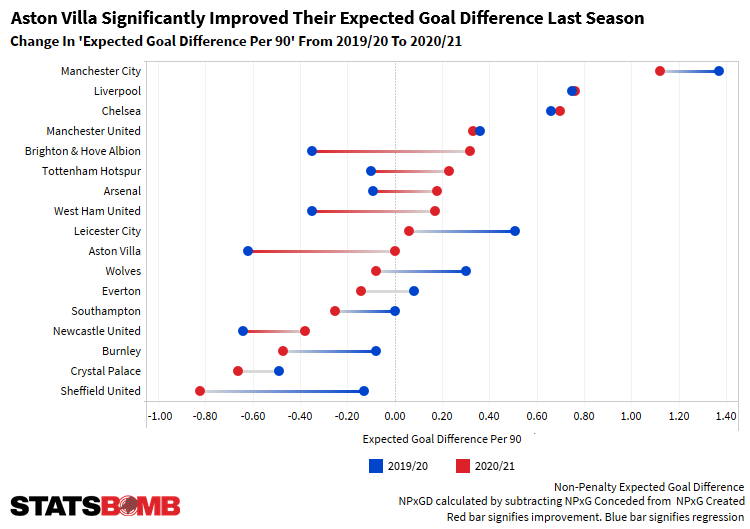 They improved at both ends of the pitch, adding 0.28 xG per game onto the attack (~10 goals a season) and shaving -0.34 xG per game off the defence (~13 goals a season). At the back, they conceded fewer shots (15.8 – 14.1) that were of a worse quality measured by xG per shot (0.10 – 0.09). They were defending better as a collective, with goalkeeper Emiliano Martínez having a stellar season when the opposition did manage to create an attempt on goal. Digging into what they did to limit the opposition, it becomes clear that Villa started to protect the goal more effectively, defending their penalty box with more bodies and a greater emphasis on making it difficult for the opposition to score. The team became more balanced and more challenging to break down – they forced their opponents average shot distance back by more than a metre, 15.8m in 2019/20 versus 16.9m in 2020/21. A difference that sounds small, but their opposition shots were 6th-closest in the league before and 17th-closest after. Besides being more difficult to break down, they also effectively prevented the opposition from getting a clear sight of goal. Villa averaged the most defenders behind the ball when their opponents took a footed shot in the box, and the most defenders between ball and goal in the same circumstances. Naturally, they also had one of the best block rates of those same shots. You can’t concede goals if the ball doesn’t test the ‘keeper in the first place.
They improved at both ends of the pitch, adding 0.28 xG per game onto the attack (~10 goals a season) and shaving -0.34 xG per game off the defence (~13 goals a season). At the back, they conceded fewer shots (15.8 – 14.1) that were of a worse quality measured by xG per shot (0.10 – 0.09). They were defending better as a collective, with goalkeeper Emiliano Martínez having a stellar season when the opposition did manage to create an attempt on goal. Digging into what they did to limit the opposition, it becomes clear that Villa started to protect the goal more effectively, defending their penalty box with more bodies and a greater emphasis on making it difficult for the opposition to score. The team became more balanced and more challenging to break down – they forced their opponents average shot distance back by more than a metre, 15.8m in 2019/20 versus 16.9m in 2020/21. A difference that sounds small, but their opposition shots were 6th-closest in the league before and 17th-closest after. Besides being more difficult to break down, they also effectively prevented the opposition from getting a clear sight of goal. Villa averaged the most defenders behind the ball when their opponents took a footed shot in the box, and the most defenders between ball and goal in the same circumstances. Naturally, they also had one of the best block rates of those same shots. You can’t concede goals if the ball doesn’t test the ‘keeper in the first place. 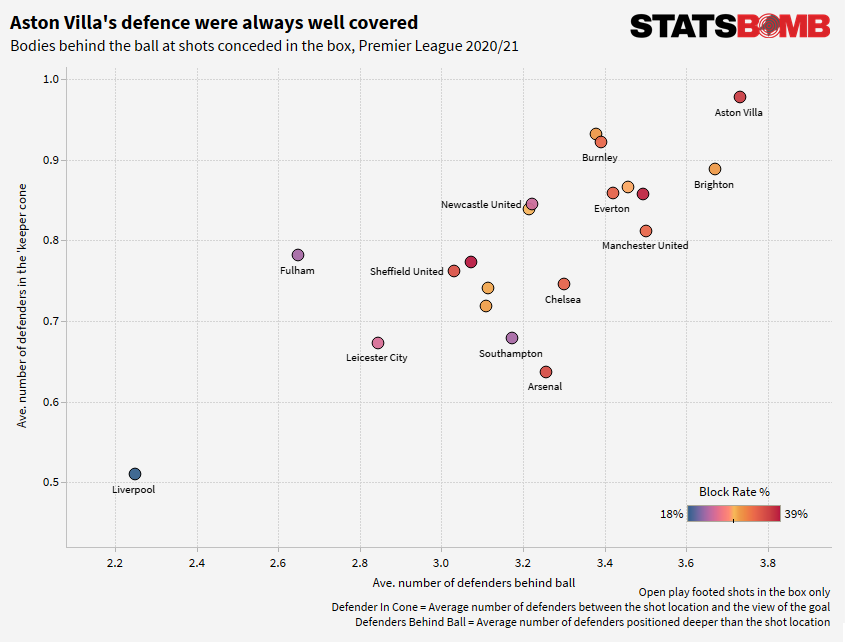 As good as the improvement was, Villa struggled in the second half of the season. They closed the season with a 4-4-6 record to take just 16 points from 14 games, worth 43 points when extrapolated over the whole season, solid bottom-half form. It could be an indicator of what may come next season, with the run coinciding with the injury to *klaxon* Jack Grealish (I made it this far without saying his name), but even with signings brought in to replace him, there was still a worrying decline in the underlying numbers. Both defence and attack got worse.
As good as the improvement was, Villa struggled in the second half of the season. They closed the season with a 4-4-6 record to take just 16 points from 14 games, worth 43 points when extrapolated over the whole season, solid bottom-half form. It could be an indicator of what may come next season, with the run coinciding with the injury to *klaxon* Jack Grealish (I made it this far without saying his name), but even with signings brought in to replace him, there was still a worrying decline in the underlying numbers. Both defence and attack got worse. 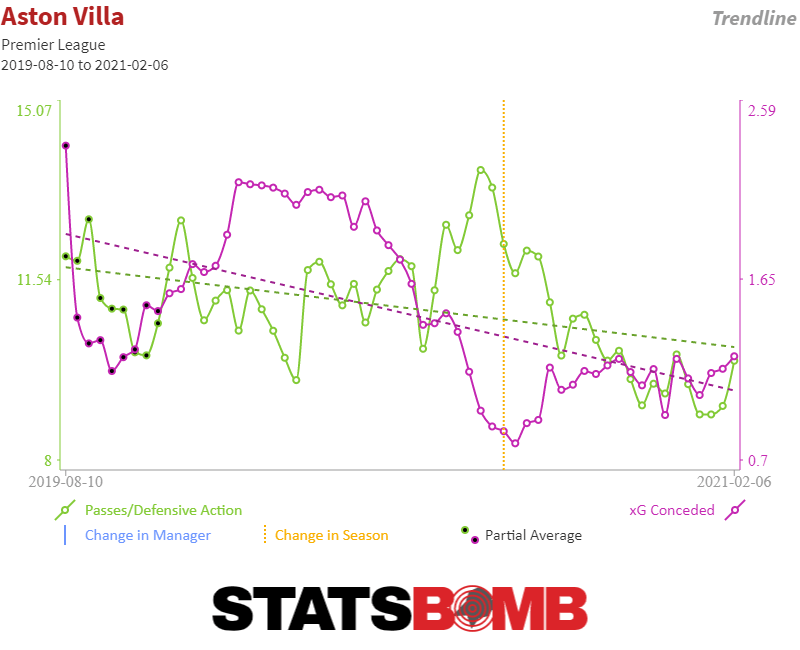 Right then, let’s hang around no longer. Time to address the big question that everyone’s asking. How will Villa cope without Jack Grealish? A look at Villa’s most common build-up patterns has the thick-calved Brummie’s footprints all over them. Nearly all of their play was filtered down the left-hand side where Grealish would situate and perform his best work, combining with Ollie Watkins and Matt Targett and laying on chances for his teammates.
Right then, let’s hang around no longer. Time to address the big question that everyone’s asking. How will Villa cope without Jack Grealish? A look at Villa’s most common build-up patterns has the thick-calved Brummie’s footprints all over them. Nearly all of their play was filtered down the left-hand side where Grealish would situate and perform his best work, combining with Ollie Watkins and Matt Targett and laying on chances for his teammates. 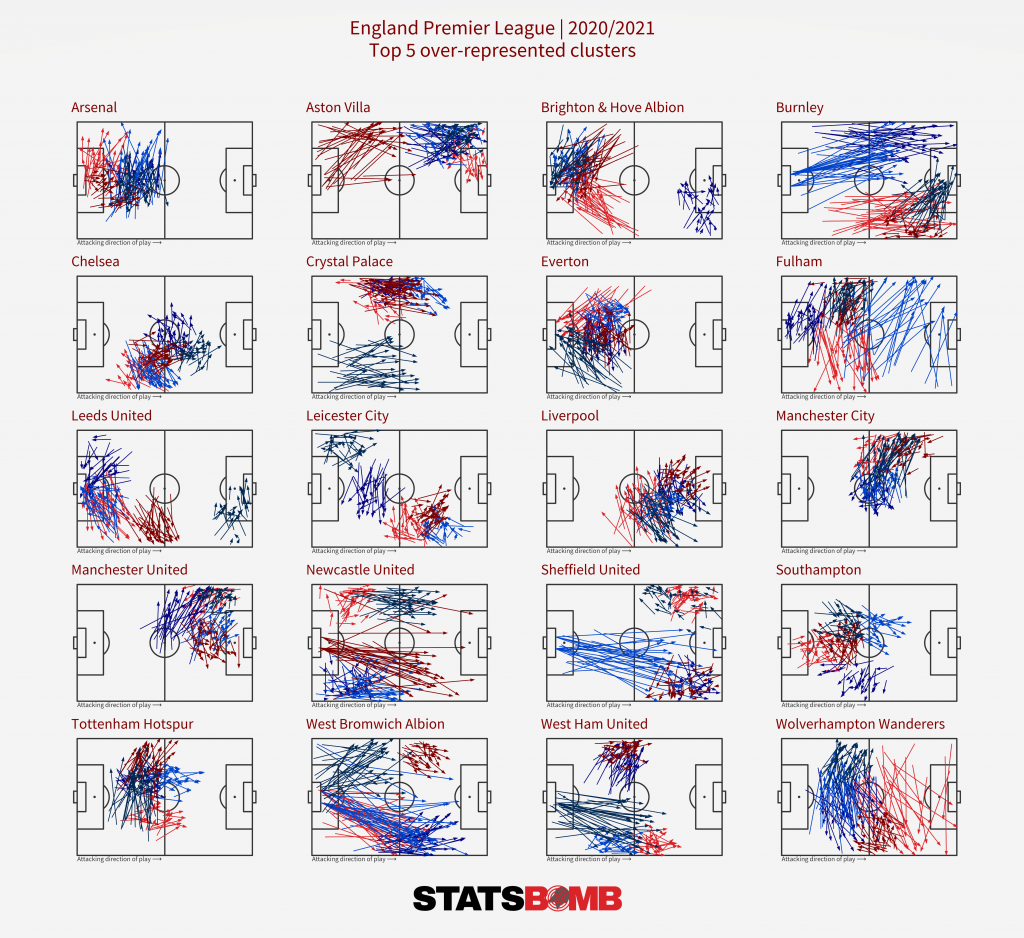
 Grealish was on a different level to his teammates last season, and indeed most of the Premier League. Our new possession value model, On-Ball Value, assigns a positive or negative value to each action performed on the pitch based on its impact on a team’s chances of scoring or conceding. Players such as Kevin De Bruyne, Trent Alexander-Arnold, and Mohamed Salah all performed well by this measure. Guess who topped the league?
Grealish was on a different level to his teammates last season, and indeed most of the Premier League. Our new possession value model, On-Ball Value, assigns a positive or negative value to each action performed on the pitch based on its impact on a team’s chances of scoring or conceding. Players such as Kevin De Bruyne, Trent Alexander-Arnold, and Mohamed Salah all performed well by this measure. Guess who topped the league? 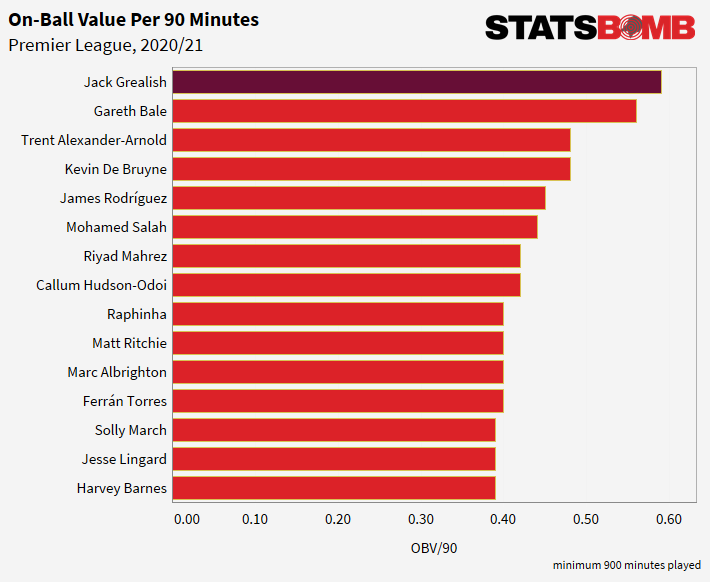 Looking purely at chance creation output metrics, Grealish’s importance to Villa’s attacking play becomes apparent. He was responsible for an overwhelming portion of their chance creation – 23% of Villa’s assisted xG was created by Grealish – and he was also responsible for taking 9% of their xG himself, behind only Ollie Watkins, Bertrand Traoré and Anwar El Ghazi.
Looking purely at chance creation output metrics, Grealish’s importance to Villa’s attacking play becomes apparent. He was responsible for an overwhelming portion of their chance creation – 23% of Villa’s assisted xG was created by Grealish – and he was also responsible for taking 9% of their xG himself, behind only Ollie Watkins, Bertrand Traoré and Anwar El Ghazi. 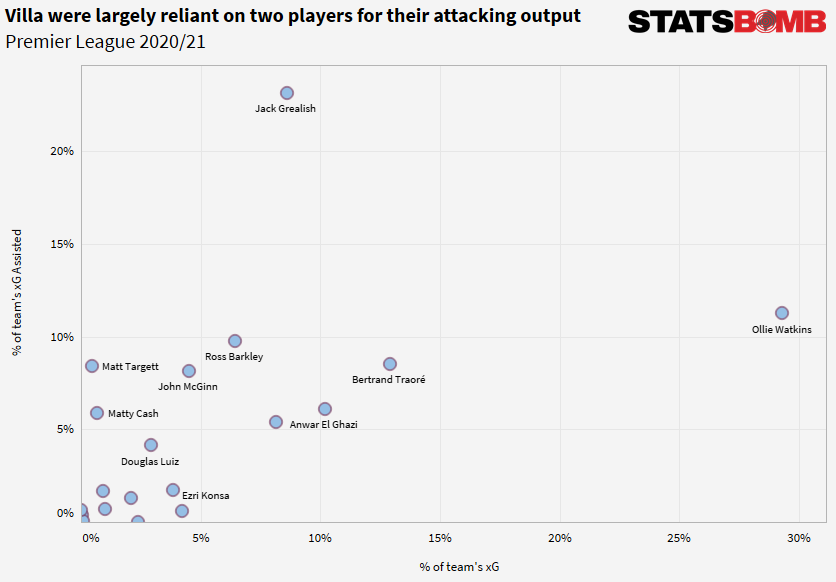 The scatterplot highlights the need for Villa to become less reliant on Grealish – of which they have no choice – and Ollie Watkins, with Watkins responsible for 29% of Villa’s xG. It’s not unusual for a team to have a focal point who finishes most of their chances, but it does leave them in a precarious position without a) adequate contributions from elsewhere in the team and b) quality backup should Watkins get injured. Upon Grealish’s nine-figure sale to Manchester City, Villa CEO Christian Purslow published a statement that specifically addressed the transfer. In the statement, he said:
The scatterplot highlights the need for Villa to become less reliant on Grealish – of which they have no choice – and Ollie Watkins, with Watkins responsible for 29% of Villa’s xG. It’s not unusual for a team to have a focal point who finishes most of their chances, but it does leave them in a precarious position without a) adequate contributions from elsewhere in the team and b) quality backup should Watkins get injured. Upon Grealish’s nine-figure sale to Manchester City, Villa CEO Christian Purslow published a statement that specifically addressed the transfer. In the statement, he said:
“It was never our intention to replace Jack with one footballer. Our strategy was to analyse and break down Jack’s key attributes - his creativity, his assists, and his goals - and to find these qualities, and others, in three forward players.”
In come Danny Ings from Southampton, Leon Bailey from Bayer Leverkusen, and Emi Buendía from Norwich. By bringing Buendía in, Villa have in many ways done to Norwich what Manchester City have done to them. Buendía was the creative hub at Norwich, a player that stood out above the rest, and was responsible for a very similar amount of Norwich’s output, with 22% of Norwich xG Assisted coming through the Argentine and 16% of their xG. It’s not just in the final third that Buendía can do it though. He was one of the most active defenders in the Championship last season, registering more possession-adjusted pressures than anyone else in the league. His overall contribution was key to Norwich’s play both in and out of possession, and Buendía was third in the Championship for On-Ball Value, taking into account all his actions on the pitch. 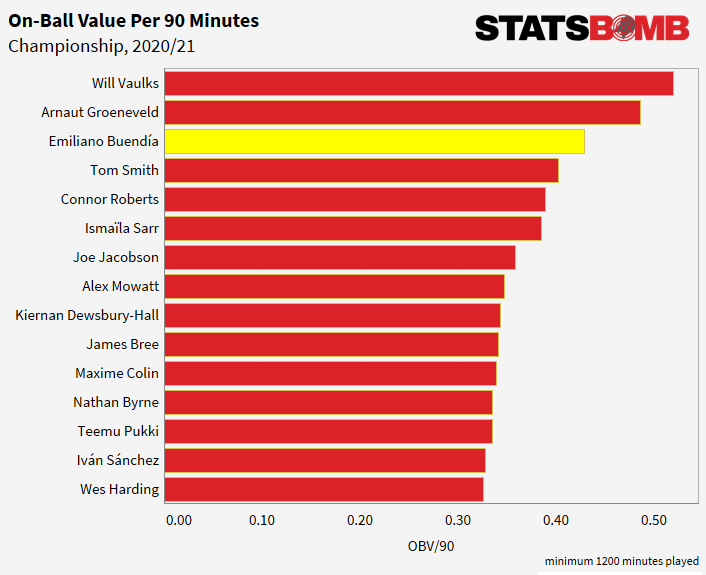 Leon Bailey is an established top-tier player on the European circuit after four seasons in the Bundesliga with Bayer Leverkusen. Last season was arguably Bailey’s strongest since moving to Germany, contributing nine goals and seven assists as Leverkusen finished 6th to qualify for the Europa League. His experience as a high performer in a big five league and on the European stage, having played in the Champions League and the Europa League, makes him an exciting prospect to evaluate.
Leon Bailey is an established top-tier player on the European circuit after four seasons in the Bundesliga with Bayer Leverkusen. Last season was arguably Bailey’s strongest since moving to Germany, contributing nine goals and seven assists as Leverkusen finished 6th to qualify for the Europa League. His experience as a high performer in a big five league and on the European stage, having played in the Champions League and the Europa League, makes him an exciting prospect to evaluate. 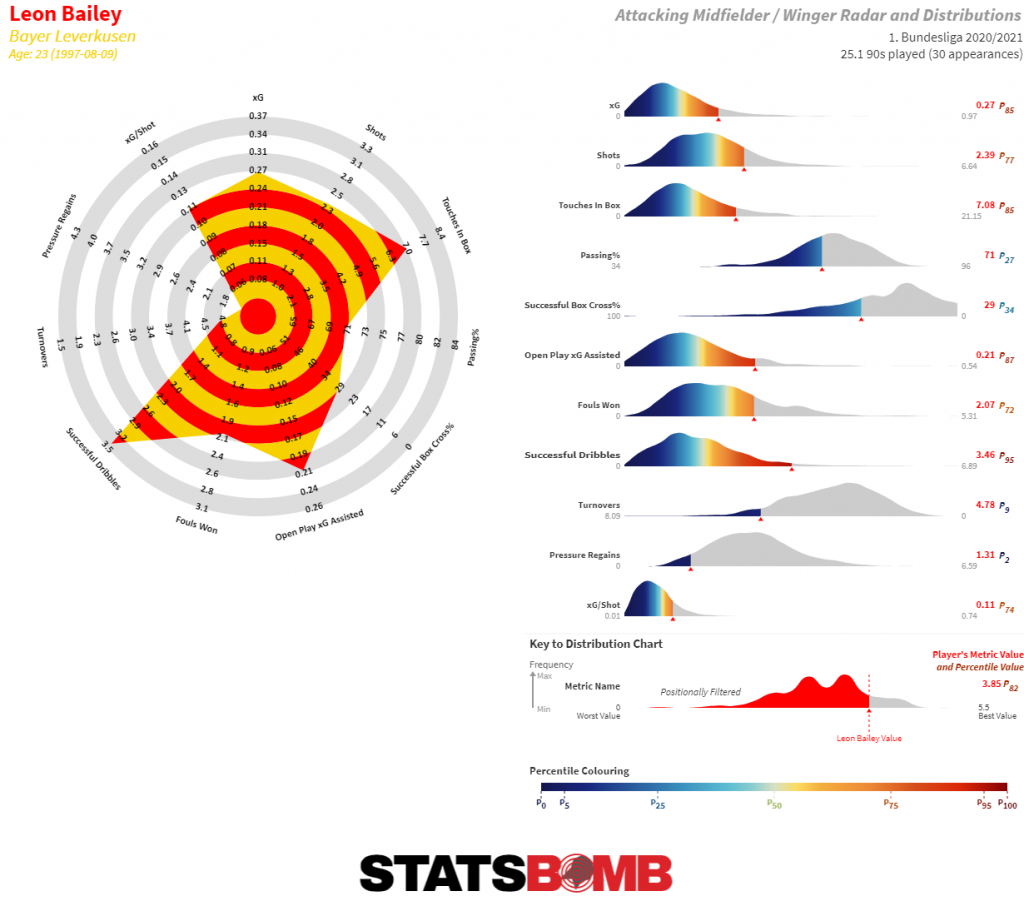 Where Buendía may provide the guile, the incisive passing, and the chance creation, Bailey’s profile leans more towards that of a dribbler and zone-mover, who can contribute goals from inside the penalty box as well. Bailey completed 3.5 dribbles per 90 in 2020/21 (5th in the Bundesliga) and had an average carry length of 6.5 metres (9th). Bailey looks like the most likely candidate to replace Grealish’s elite ball-carrying ability.
Where Buendía may provide the guile, the incisive passing, and the chance creation, Bailey’s profile leans more towards that of a dribbler and zone-mover, who can contribute goals from inside the penalty box as well. Bailey completed 3.5 dribbles per 90 in 2020/21 (5th in the Bundesliga) and had an average carry length of 6.5 metres (9th). Bailey looks like the most likely candidate to replace Grealish’s elite ball-carrying ability. 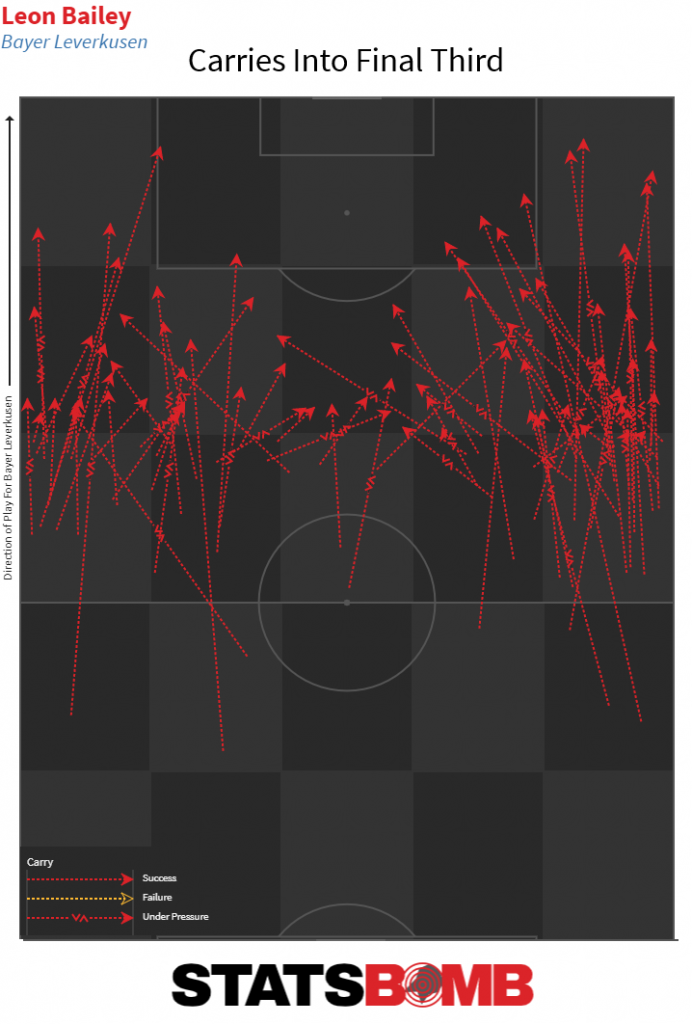 It’s also encouraging that he doesn’t seem prone to wasting possession with shots from range, his xG per shot of 0.11 is towards the higher end you’d expect from a wide forward - a trait that he appears to have had throughout his career. The third signing was that of Danny Ings, a transfer that came as a surprise to everyone except Danny Ings, Southampton, or Aston Villa. Ings is a known quantity in the Premier League so it’s obvious what he brings to the squad: work rate out of possession and a steady contribution to the Goals For column. As part of Operation Replace Jack, Ings is a less direct replacement, but should play a key role in easing the goalscoring burden placed on Ollie Watkins while also giving Dean Smith the option to play two up front. Age and injury record have been raised as possible red flags against the fee outlay, but he’s a player that you’d trust to contribute goals--as long as the new Villa setup creates chances.
It’s also encouraging that he doesn’t seem prone to wasting possession with shots from range, his xG per shot of 0.11 is towards the higher end you’d expect from a wide forward - a trait that he appears to have had throughout his career. The third signing was that of Danny Ings, a transfer that came as a surprise to everyone except Danny Ings, Southampton, or Aston Villa. Ings is a known quantity in the Premier League so it’s obvious what he brings to the squad: work rate out of possession and a steady contribution to the Goals For column. As part of Operation Replace Jack, Ings is a less direct replacement, but should play a key role in easing the goalscoring burden placed on Ollie Watkins while also giving Dean Smith the option to play two up front. Age and injury record have been raised as possible red flags against the fee outlay, but he’s a player that you’d trust to contribute goals--as long as the new Villa setup creates chances. 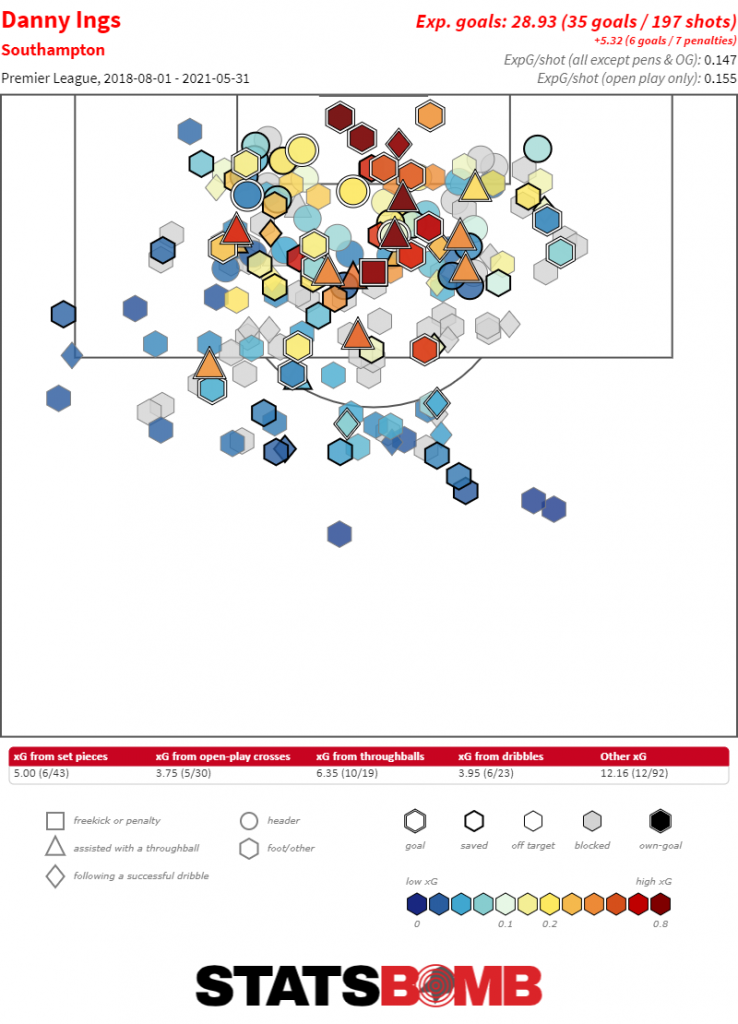 Projection So then, we await to see what happens when you take one of the best Premier League players out of a midtable side. The logic to Villa’s business is sound; they were overreliant on Grealish for several aspects of their play, and the three players should decentralise their build-up and make the team better as a whole, while also lessening the risk should injuries occur, a risk Villa are all too aware of after what happened at the end of last season. The points spreads predict a minor regression for the club, still in midtable but benchmarked at 49 points, a six-point drop-off from 2020/21. The impact of the new players is uncertain and there are valid concerns over the form Villa showed in the run-in, so this seems like a more than reasonable benchmark to aim for in season one of the regeneration. It’s important to remember that Villa spent multiple seasons in the Championship in recent history; back-to-back midtable finishes would be a sound return in establishing themselves in the Premier League once more.
Projection So then, we await to see what happens when you take one of the best Premier League players out of a midtable side. The logic to Villa’s business is sound; they were overreliant on Grealish for several aspects of their play, and the three players should decentralise their build-up and make the team better as a whole, while also lessening the risk should injuries occur, a risk Villa are all too aware of after what happened at the end of last season. The points spreads predict a minor regression for the club, still in midtable but benchmarked at 49 points, a six-point drop-off from 2020/21. The impact of the new players is uncertain and there are valid concerns over the form Villa showed in the run-in, so this seems like a more than reasonable benchmark to aim for in season one of the regeneration. It’s important to remember that Villa spent multiple seasons in the Championship in recent history; back-to-back midtable finishes would be a sound return in establishing themselves in the Premier League once more.
Want to read about another team? The rest of our Premier League season previews can be found here If you're a club, media or gambling entity and want to know more about what StatsBomb can do for you, please contact us at Sales@StatsBomb.com We also provide education in this area, so if this taste of football analytics sparked interest, check out our Introduction to Football Analytics course Follow us on Twitter in English and Spanish and also on LinkedIn
The introduction to last year's Leicester season preview reads:
It’s extremely uncharitable to take a look back at 2019-20 and declare it anything other than a success for Leicester. Yes, Champions League qualification looked likely for most of the season, and to miss out was ultimately a disappointment, but the trajectory and outcome were more than fine.
So, I guess it appears as though Leicester are destined to live out the same season over and over again, in some weird Edge of Tomorrow like fashion. Champions League qualification looked likely, they were disappointed to miss out, but the trajectory and 5th place outcome were more than fine, AND they took home an FA Cup for their troubles this time around. It’s the trajectory that counts and Leicester are certainly on the right track.
The Headline Numbers
Whilst on the surface Leicester's 5th place finish matched their 2019/20 placing, when you dig a little deeper there's actually been quite a bit of change. Firstly, the underlying numbers have taken a hit from the lofty heights they set in 2019/20 when they finished 4th for expected goal (xG) difference. Last season only Sheffield United dropped off more in this regard.
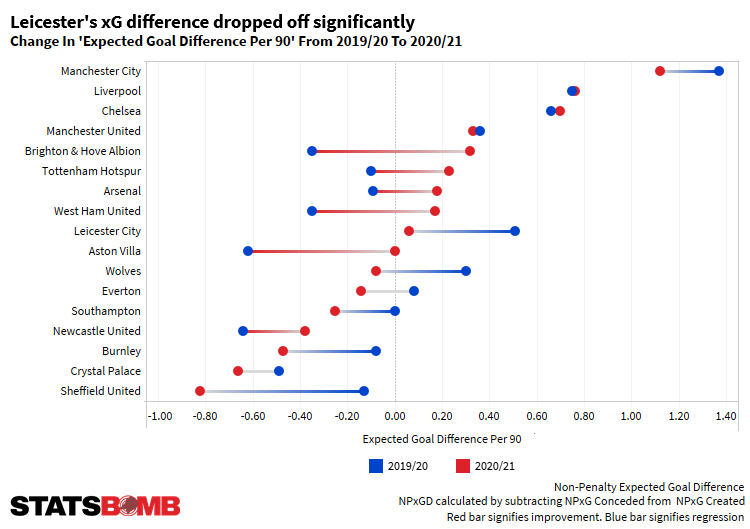
All of their overperformance came in attack. They conceded 46 goals from 46 xG, but up front scored 58 goals from 47 expected. Kelechi Iheanacho, James Maddison and Harvey Barnes ran especially hot, with Iheanacho's emergence as a reliable goalscorer in particular really helping to propel the Foxes into European contention, notching 12 goals from seven xG.
Iheanacho’s contribution was especially important given that Jamie Vardy had his first poor finishing season in four campaigns, flipping Iheanacho’s conversion rate by getting seven goals from 12 xG. Looking across the season as a whole, you can see the oh-so-difficult Christmas period that really hurt the underlying numbers, even if actual results around that period weren't so bad. Something that many teams struggled with in a particularly intense fixture schedule in 2020/21.
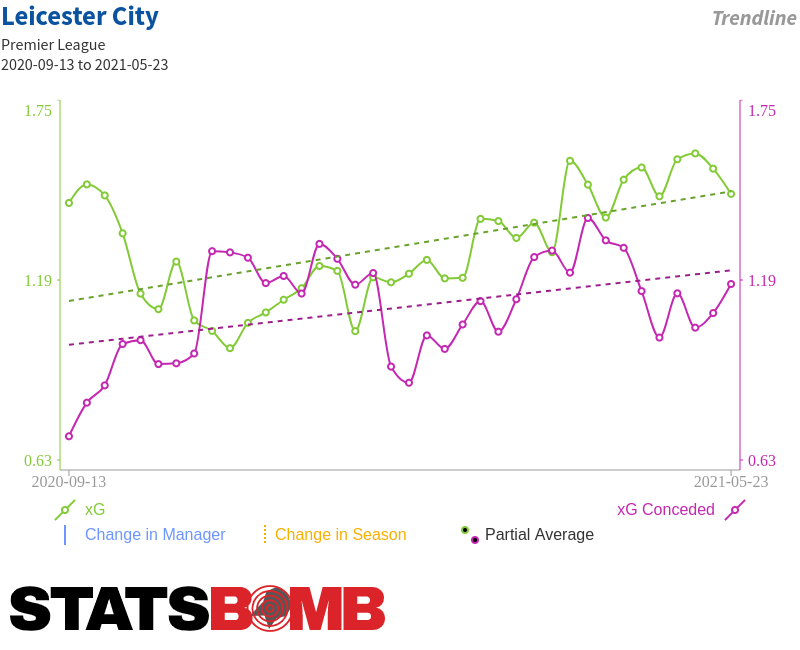
We get some interesting results when we break these xG numbers down further by looking at Leicester's xG difference during each game state.
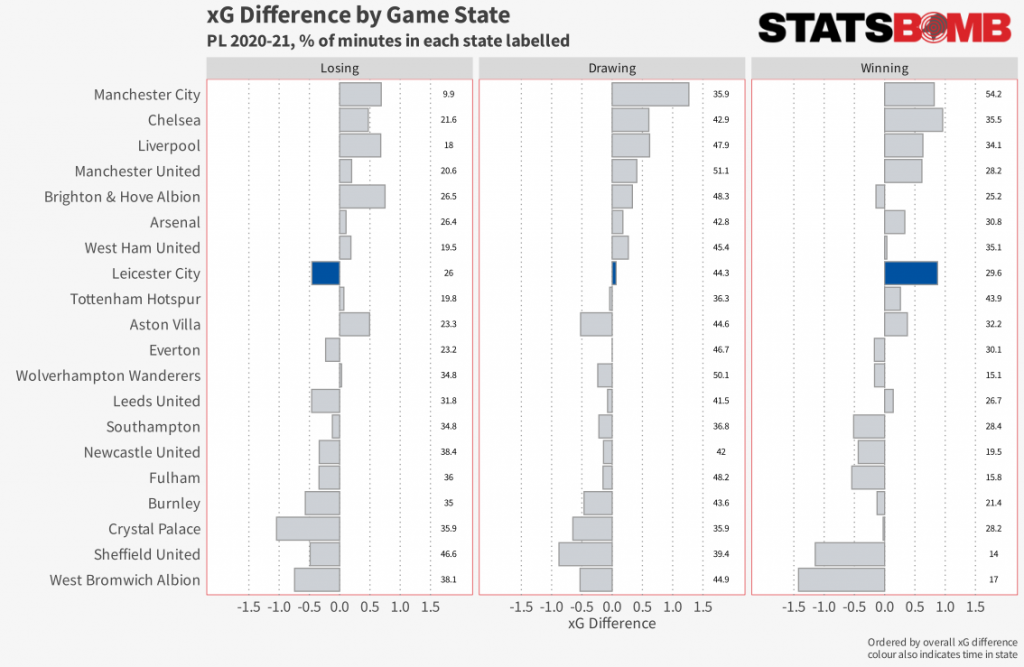
Here you can see that Leicester are an exceptional team when they're winning, which is perhaps no surprise given the attacking talents they have to play in transition and Brendan Rodgers’ track record of setting teams up to play efficiently on the break.
The squad lends itself to this approach: Vardy is notoriously great in this phase of the game, Barnes is a fantastic ball carrier at pace, and then you have Maddison and Youri Tielemans who can play the high-value pass whilst having enough mobility to stay with the play. On the other hand, Leicester really struggle when losing. They don't have trouble moving the ball into the final third - they ranked 6th for deep progressions - but keeping the ball in-and-around the box has not been a strength of theirs as they rank 13th for deep completions (successful passes within 20 meters of goal).
A large factor in their struggles when behind is that their xG per shot drops from 0.13 to 0.08, meaning they either resort to lower-quality efforts on goal or they struggle to break down teams defending a lead. Their most common pass clusters tell a similar story of ball progression, but only up to the final third. They're also quite lopsided in the opposition half - a lot of play goes through Tielemans and subsequently Iheanacho, who's much more involved than his striker partner Vardy.

Let's dig deeper into whether those passes are providing value. Our new possession value model, On-Ball Value (OBV), rates the impact of each action on the pitch and estimates the positive or negative impact the action has on a team’s likelihood of scoring. The OBV Leicester generate across the pitch when they’re behind versus when they’re ahead is revealing:
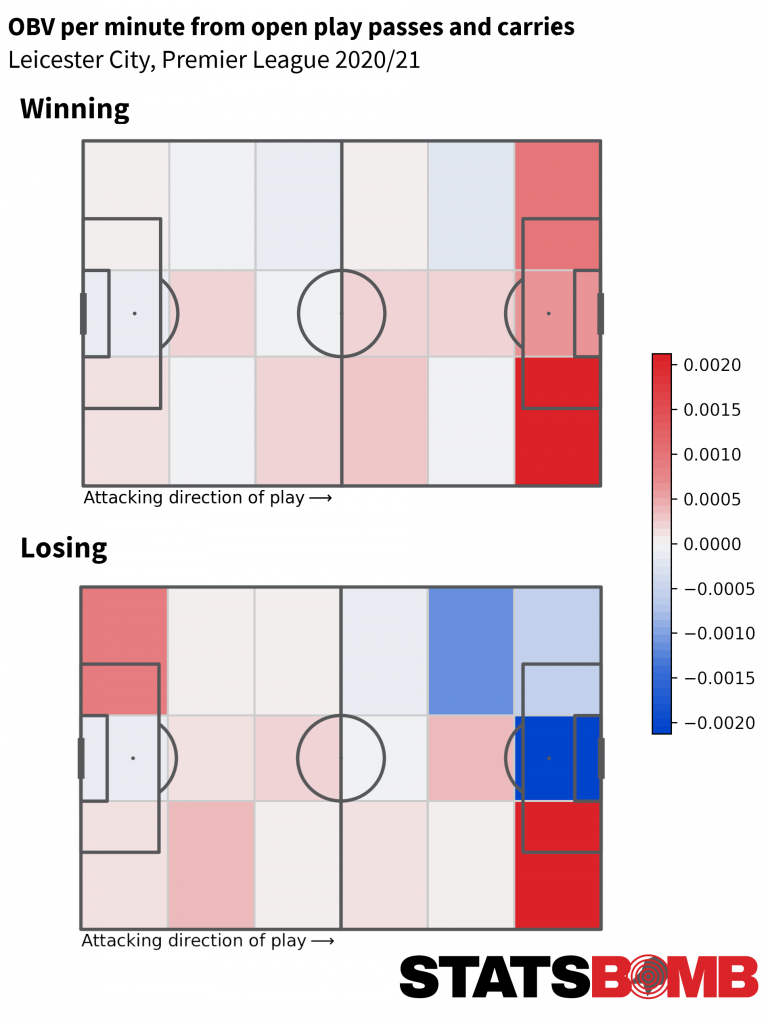
That right-sided bias is showing through again and it becomes more prominent when they're chasing the game, but they still generate plenty of OBV in deeper areas down that right-hand side regardless of game state. In contrast, the left side is a bit of a black hole when Leicester are losing - hopefully Barnes can return to his best and resolve much of this - he clocked the 16th highest OBV per 90 last season after all, for players with >900 minutes played.
Where Leicester found it difficult to create high-value chances against their opponents when behind, their opponents did not find it as difficult to create high-value chances against them. When Leicester were pushing for equalisers, their xG per shot conceded rocketed up to 0.21--their opponent's shots in this game state had a 1-in-5 chance of being converted.
The evidence suggests that Leicester struggled to manage the threat of the counter when they were pushing to get back in the game. The xG trendline also shows their xG conceded has been creeping upwards, so what's going on at the back? One explanation might be Leicester's pressing, which was down quite a bit last season.
This is despite an ongoing uptick in defensive activity since Rodgers' arrival, so it seems unlikely this was a deliberate change in approach. Leicester averaged 168 pressures per 90 in 2019-20 compared to just 135 last season. Now a lot of this will be down to the crowded schedule, and we saw pressures drop on the whole across most leagues, but Leicester appear to have suffered more than most. Here's the defensive activity maps for both seasons:
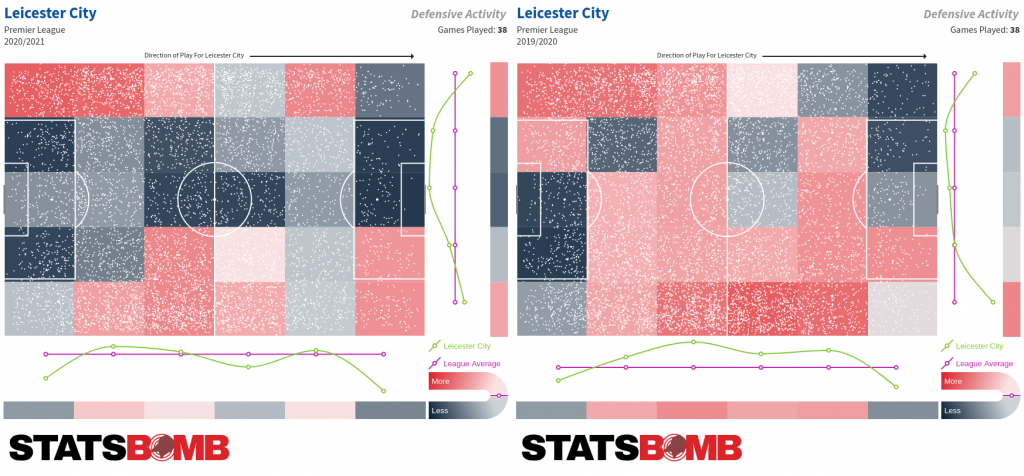
The Squad
The Foxes have developed a reputation for being shrewd operators in the transfer market, showing great patience to build the squad up again since the title-winning season. It can be difficult when squad building to balance future potential versus immediate strength, and they've executed particularly well to maintain a challenge for top four while simultaneously getting themselves into a position to continue targeting Europe for the next few years. Key players like Wilfred Ndidi, Iheanacho, Tielemans and Maddison will begin to hit their peak over the next few seasons, while Barnes, Wesley Fofana and James Justin have years ahead of them.
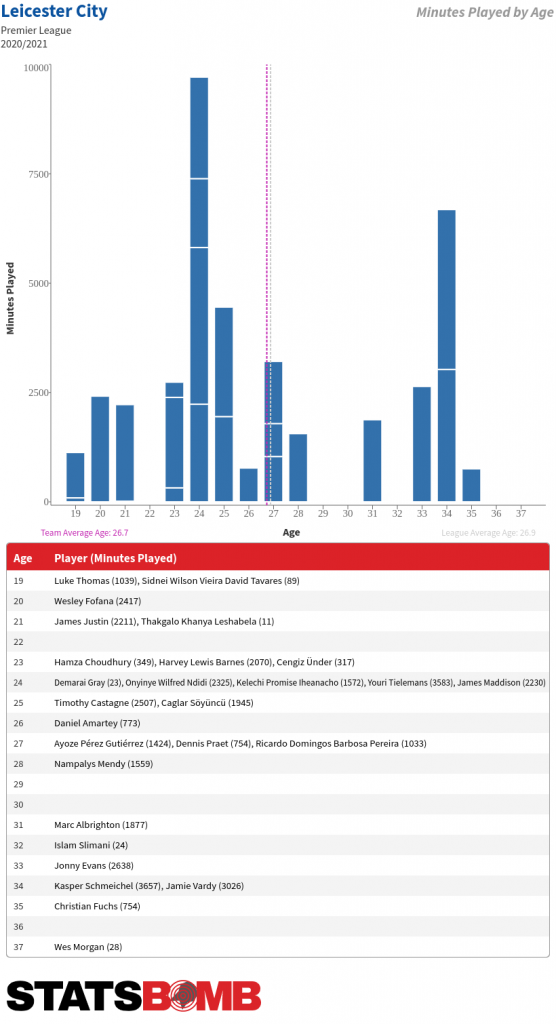
The squad was hit by some big injuries last season just as it was the season before, but it's a sign that they're operating from a solid internal process given they always have players ready to step in, whether from the academy or through recruitment.
That the forward line hasn’t needed major regeneration for a number of years is testament to Jamie Vardy’s longevity but, at 34, the time is finally getting close for him to hand the reigns over. Leicester are confident they’ve found his replacement in RB Salzburg forward Patson Daka, the big question is: is he any good?
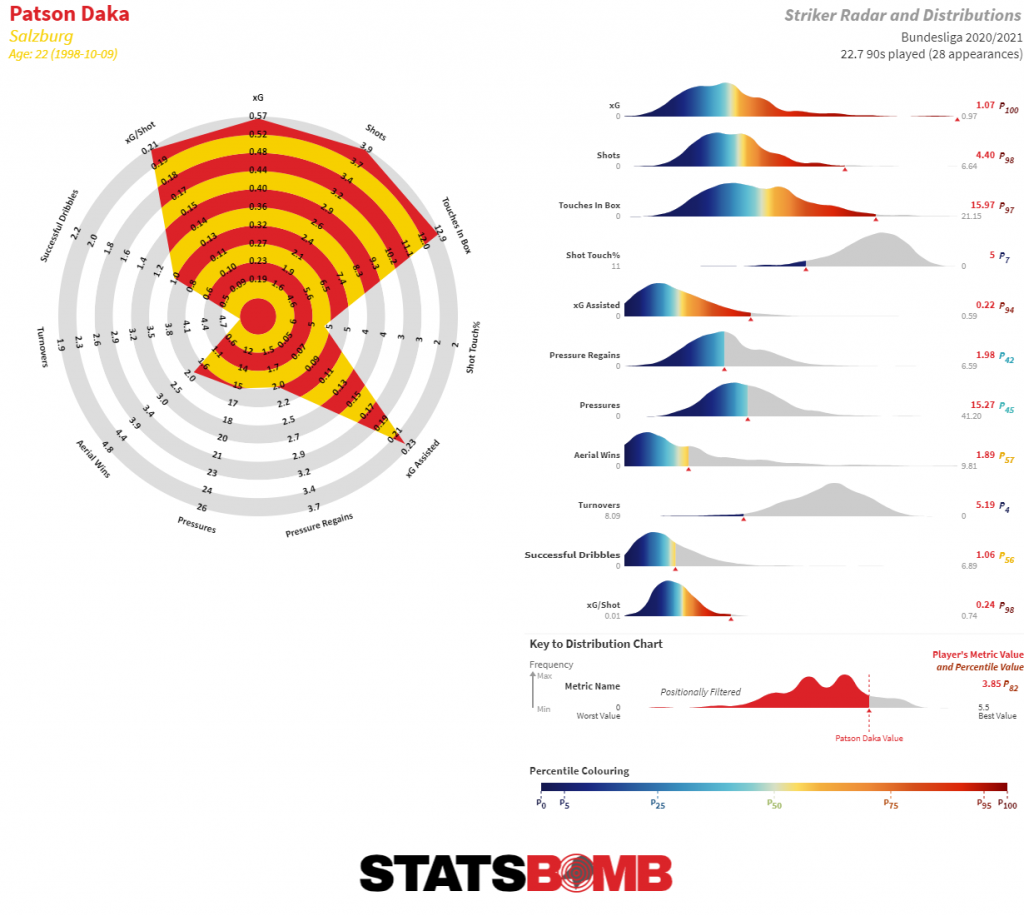
Probably! Player evaluation can be tricky when they play for a team as dominant as Salzburg are in the Austrian Bundesliga, but his numbers certainly pop. That they still pop when he plays in the Champions League is an encouraging sign, albeit the sample size gets rough.
One thing to note is that the 22-year-old shows real maturity - his shot locations are excellent and he seems to have a good understanding of his own game. Much like Vardy, he plays on the last man, is great in transition, and understands how to use his pace without the ball at his feet. It might take some time for him to find his feet, but given how Iheanacho just reminded us all that player development is rarely a smooth upward trajectory, Daka should receive plenty of slack.
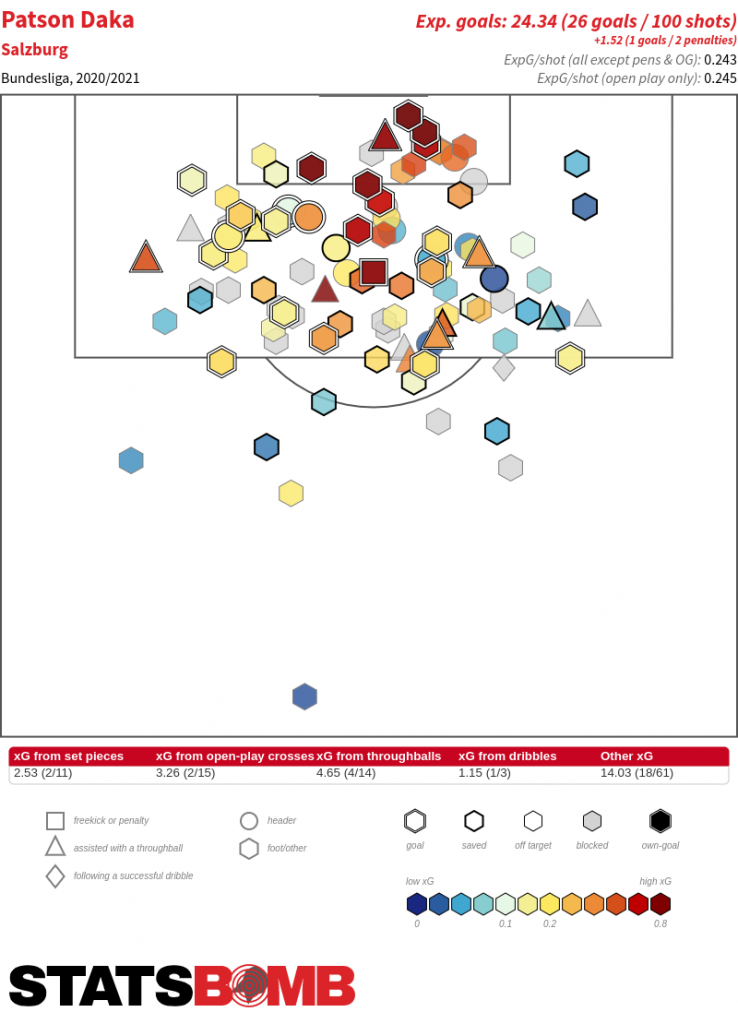
As for the other signings, it all looks very good - from the sensible in Ryan Bertrand and Jannik Vestergaard (assuming that deal gets over the line) to the downright exciting in Boubakary Soumaré.
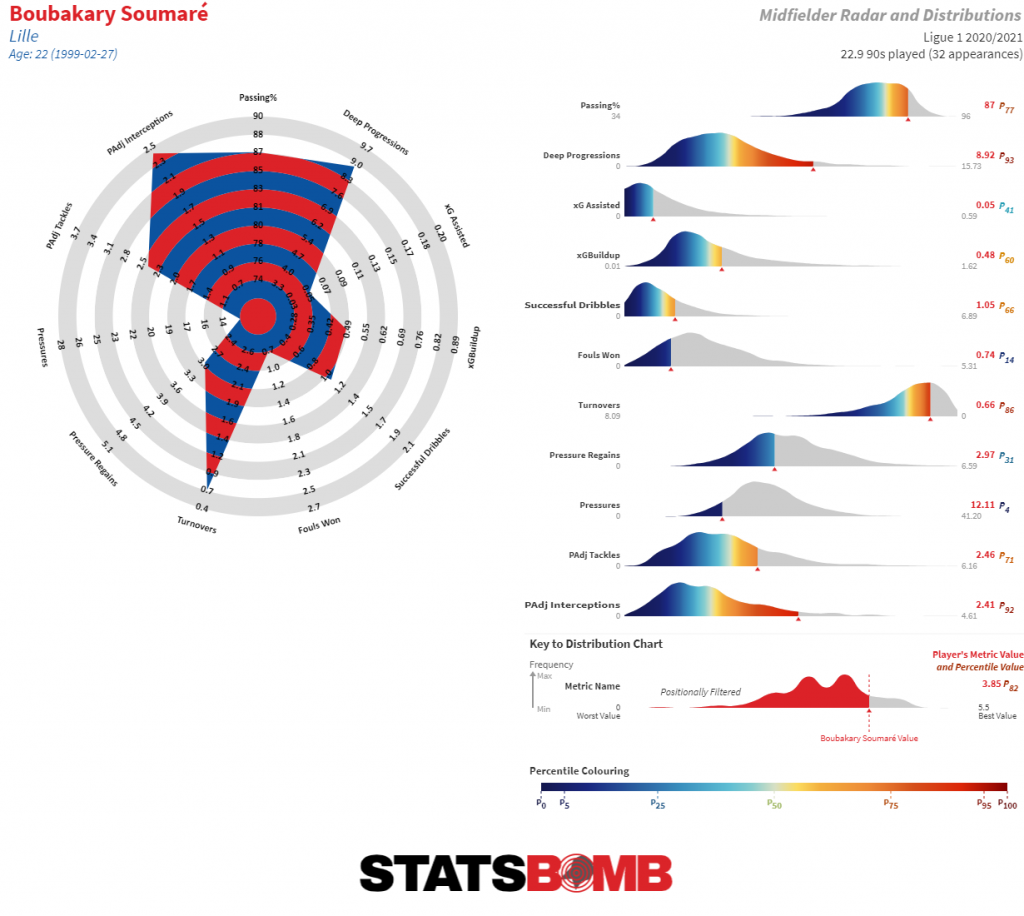
Parting Thoughts
You might be inclined to read the headline underlying numbers above and think Leicester could be in for a difficult season if they produce similar numbers to those of last season. It’s a possible outcome, but given the quality of the squad and manager, and the general outlier than last season was as a whole, it seems more likely that Leicester revert to a process that should see them knocking on the door of the Champions League places once again.
They’ve bolstered the squad with what look like top signings, and the return of Barnes should balance the attack better. As noted, we’ll need to watch out for how they perform when behind; if they continue to struggle, that could lead to dropped points that could cost them a place or two in the table. But, this team can play fantastic transition football and, with the current state of the modern game, you can go a loooong way playing great transition ball. All it takes is some better luck with injuries and one of last season's top four to have issues, and Leicester are in business.
Want to read about another team? The rest of our Premier League season previews can be found here If you're a club, media or gambling entity and want to know more about what StatsBomb can do for you, please contact us at Sales@StatsBomb.com We also provide education in this area, so if this taste of football analytics sparked interest, check out our Introduction to Football Analytics course Follow us on Twitter in English and Spanish and also on LinkedIn

